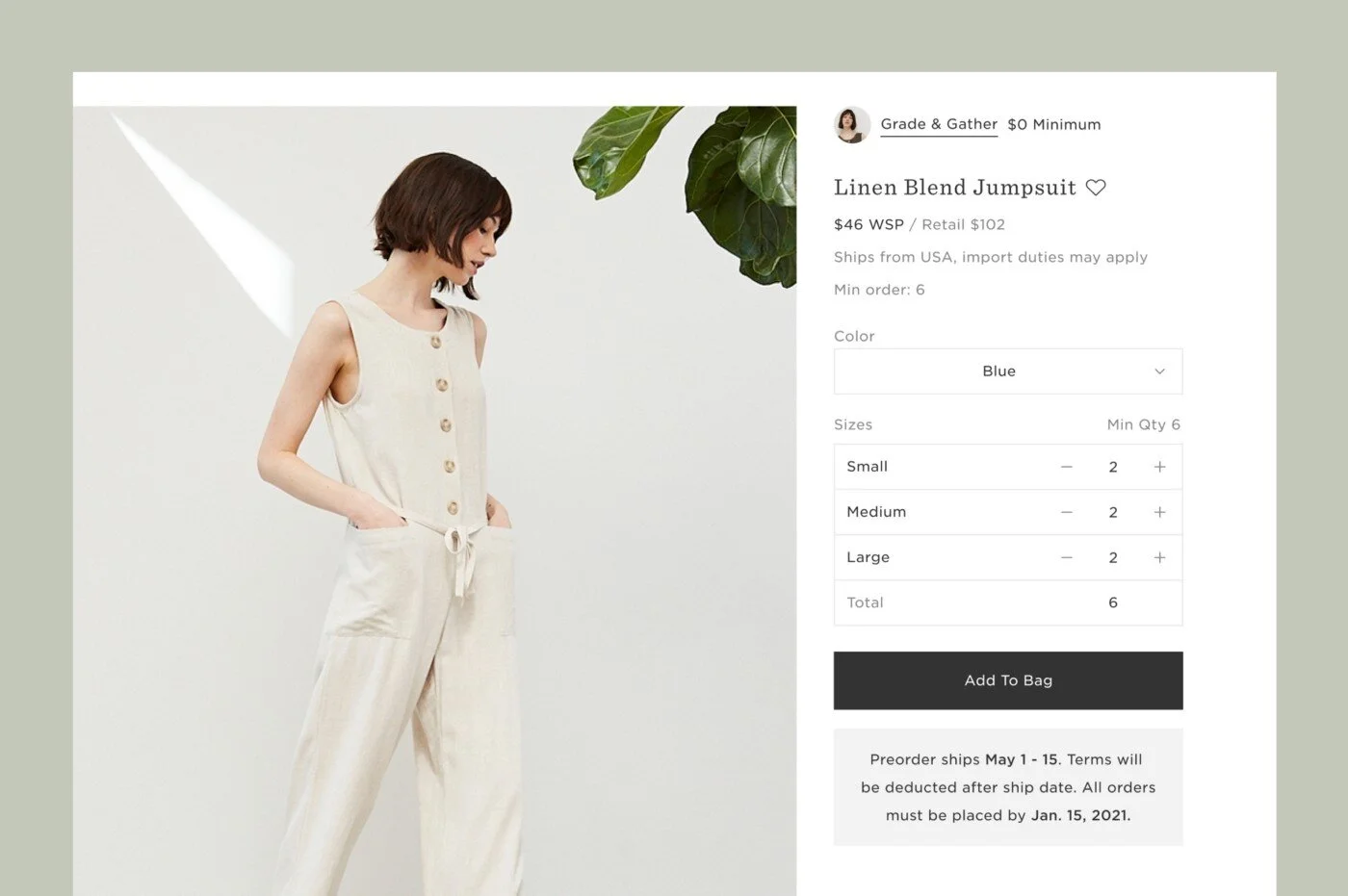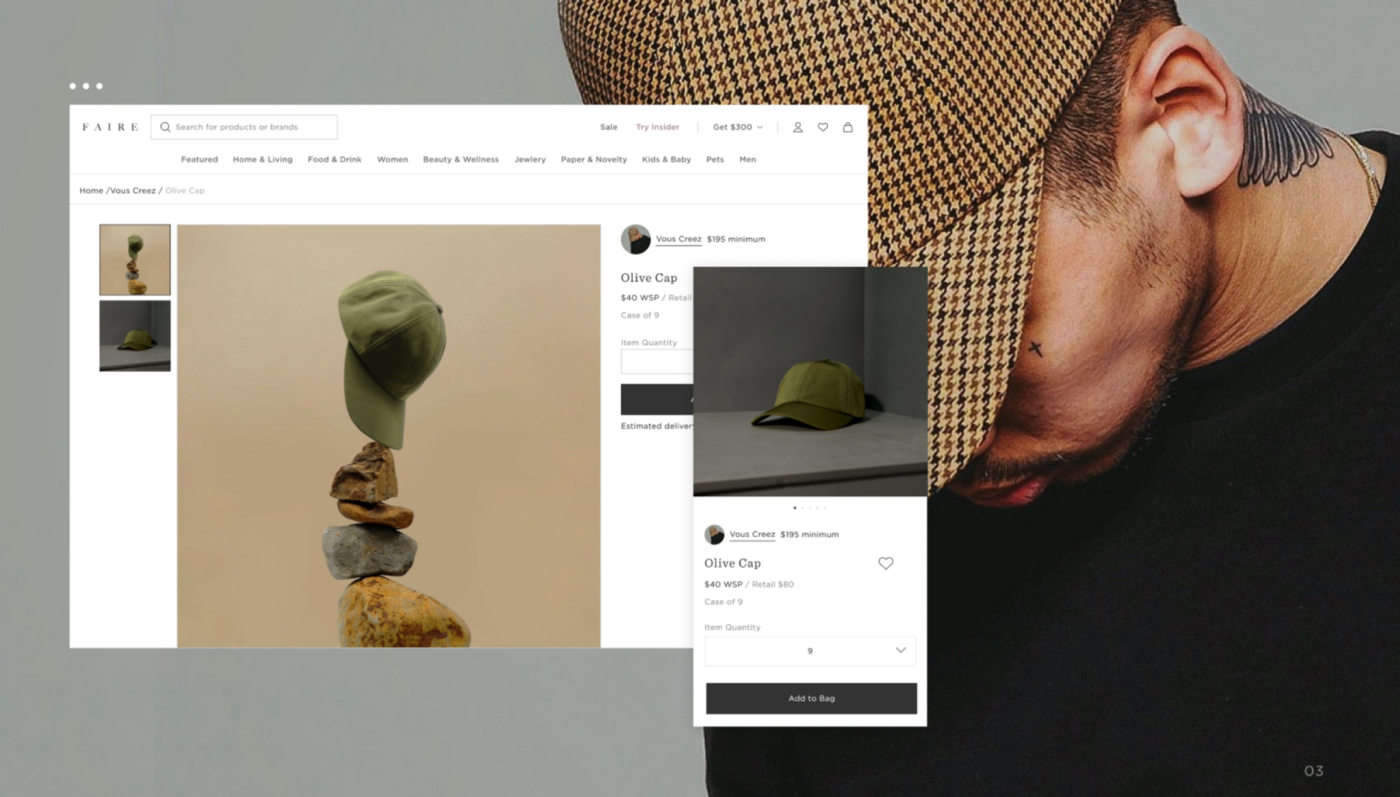What we’ve learned from designing for a unique set of users
Key insights from 12 months of research and design for Faire’s wholesale apparel platform
The Faire wholesale marketplace launched in 2017, with the goal to connect independent brands with small retailers. After starting out primarily focused on the gift category, we saw a strong signal for apparel as more clothing brands started to list goods on the platform. Then, in July 2020, we kicked off a journey to explore and better understand the wholesale apparel space, starting with an intensive research sprint interviewing 30+ brands and retailers.
Keep reading for insights on what we’ve learned over the past 12 months — and why we’re excited to grow our work in this space.
How do you design for a customer that changes their entire inventory six times a year?
One of the biggest differences between wholesale apparel and other verticals is seasonality. A good way to understand this is to think about the difference between a candle and a dress. Seasonal candles, such as a fall-themed pumpkin-spice candle, can be sold year after year with little change to the product. A summer dress, on the other hand, will fall in and out of trend, and become less desirable every month outside of its original intended buying season.
Quick trend cycles mean quick inventory turnover. In the span of 6 months, an apparel brand’s product list can change completely. Most apparel brands on Faire design for 4–6 seasons a year, compared with 1 or 2 new launches for non-apparel brands.
Given this turnover, we needed to create a way for brands to update their catalogs frequently and seamlessly. In our research, we learned that most brands manage their inventory with spreadsheets and so, early on, we explored designing custom in-product UI. However, at the end of the day our goal is to create efficiency for our customers, and that meant creating a seamless tool in the environment they’re most familiar with: the humble spreadsheet.
So, with intensive feedback from our customers, we built one of Faire’s most popular features — the Bulk Uploader. This tool enables brands to quickly update and edit their merchandise listings on the site using Excel or Google Sheets. Brands download Faire’s template, edit in the spreadsheet tool of their choice, and then upload it back into Faire where they receive an upload status report, enabling them to quickly identify any errors and make adjustments.
Spreadsheets are an incredibly powerful tool, but they’re not known for being particularly flexible with their design. Their strict cell structure and formatting rules posed a steep design challenge. We played with everything — cell color, font size, column descriptions and titles, conditional formatting, providing example rows, moving instructions to a separate tab, and more — to push the format to its limit. We needed something that was as clear and clean as possible, but still powerful enough to support brands who could be updating 10,000 rows (or products) at once — all while managing the complexities of apparel-specific selling modes, including pre-packs, open sizing, and more.
After many rounds of testing, we have a version of the Bulk Uploader that we’re happy with (for now!) that’s been very well-received by apparel brands on Faire.
How do you translate an experience that requires all of your senses to a digital platform?
One of the biggest questions retailers have when shopping online: How will this garment look and feel? Typically, wholesale retailers can get hands-on with a garment through live trade shows or in-person appointments at showrooms, exploring the garment with their eyes, ears, hands, and even noses (some retailers smell the fabric). This in-person experience allows a buyer to instantly assess a garment’s quality and fit, and determine if it’s right for their customers.
On Faire, we ask brands to share certain details about products when they upload their inventory, but keep the list of questions minimal so the process is quick and seamless. However, we realized our standard process was missing key details that were necessary for apparel retailers to judge a product — details like fit, fabric content, washing instructions, and more — so this was one of the first functionalities we built out for apparel.
Another key element of in-person shopping that’s challenging to replicate online is the buyer’s ability to immerse themselves in an apparel company’s brand, learn their story, and get inspiration on how to style the garment in their own stores. Building on these insights, the team has started to incorporate multiple new features that bring these elements to the digital realm, including live streaming and video capabilities for brands to share robust content on their shop pages.
Lastly, one of the smallest but most important changes: switching to vertical photos. Generally, product photos on Faire are square for consistency but vertical photos are a lot more compelling for apparel retailers, as it easily showcases the garment from head to toe. “Vertical images are also what we’re used to as consumers when shopping for clothes online,” explains Zhen Zeng, the Design Manager leading the Faire Apparel workstream. “So it feels more natural.”
Vous Creez, a Faire headwear brand founded in California
How do you make browsing online as inspiring as discovering products in person?
Since Faire is partly a product discovery platform, we needed a way to accurately recommend products that fit a retailer’s desired aesthetic — something that’s easy to identify when looking at a garment but needed to be translated to a digital experience and industry standard nomenclature. Part of the challenge was defining a list of aesthetics, since there isn’t a direct overlap between apparel and other verticals. “For example, ‘mid-century modern’ as a category makes sense for furniture, but not for clothing,” explains Senior Product Designer Sophie Latulippe.
We worked closely with our apparel success team to define a list of aesthetics that brands could use to tag their products. We now have aesthetic categories for boho, classic, and more — as well as an apparel-specific search category tree — which makes it easier for retailers to discover the curated clothing items that are right for their shops, as easily as if they were browsing in person. All of these changes pave the way for what’s next: helping retailers shop the merchandising story of their stores by offering intuitive ways to view, plan, and purchase apparel items — all from their couch.
How do you update a decades-old business model?
Preorders are an important milestone in the apparel wholesale lifecycle. Similar to a Kickstarter, preorders are a way to predict demand for a given item, and reduce risk prior to manufacturing it. In the apparel industry, a brand will share details 3–6 months about their line ahead of time, and accept preorders for those styles.
This is a capital-intensive process for brands. When a preorder style is produced, brands then need to front the capital for the manufacturing costs and typically won’t get paid until after the order is shipped. For apparel brands, this cash flow problem is especially acute given the long production cycles in clothing. Not having the cash upfront can sometimes mean not being able to produce everything their customers want — a treacherous self-perpetuating cycle that can slow a company’s growth.
This presented a unique business design challenge. Building on the unique risk-free incentives Faire offers to all retailers, the team saw an opportunity to break the pattern by offering brands an upfront deposit — a percentage of their Faire preorder sales — to balance cash flow across the garment production cycle. Though the preorder deposit model isn’t new for the apparel industry, it’s usually paid for by brands, not a third party.
This unique offering gives brands more flexibility in their workflows, helping them fulfill their preorders, meet demand, and ultimately grow their companies. By designing with these business challenges in mind, Faire is changing how the wholesale landscape operates and paving the way for new businesses to thrive.
Finding the right fit
As an emerging player in the wholesale apparel space, there’s still a lot for us to do, test, and design for as we make Faire more apparel-native. As Zhen explains, “Apparel is like a startup within a startup at Faire, and we’re far from done designing solutions for our users.”
So what’s next? Looking ahead, we’re excited about the possibility of designing new features that help Faire be a creative partner to retailers, assisting them in planning and styling their purchases, and using data to power those recommendations. We’re also planning Faire Fashion Week, our first apparel preorder event, coming in August.
Ultimately, our work is about helping retailers become more successful in their businesses and have more time to pursue the creative aspects of their work — their true passion. We’re staying close to this group of users and interview them weekly, often daily, so that we can continue to design for their needs. Sophie sums it up:
“At Faire, we have a very customer-centric culture. We do really believe that the closer you are to a customer, the better you’re going to be able to build a product for them. There’s a lot we don’t know, and it’s about finding the right people to learn it from.”
Whether that’s helping people buy and sell candles, clothing, or some other product, we want brands and retailers to feel like a partner in Faire’s success, and designing with them — not just for them — will help get us there.




